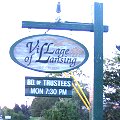- By Dan Veaner
- News
 Print
Print  It started in 2009 when the Town of Lansing asked the Village of Lansing to pay what it actually costs to plow the Village streets in the winter. At that time Village Mayor Donald Hartill said that the Village could plow its own streets for almost $17,000 less, and the Town no longer plows village roads. Hartill then began studying the rest of the town budget. Last November he said that of the $700,000 the Town levies villagers, they only receive about $100,000 worth of services. He began studying options up to and including the Village seceding from the Town. Hartill reported Monday to Village Trustees on progress he has made in researching the Village's options.
It started in 2009 when the Town of Lansing asked the Village of Lansing to pay what it actually costs to plow the Village streets in the winter. At that time Village Mayor Donald Hartill said that the Village could plow its own streets for almost $17,000 less, and the Town no longer plows village roads. Hartill then began studying the rest of the town budget. Last November he said that of the $700,000 the Town levies villagers, they only receive about $100,000 worth of services. He began studying options up to and including the Village seceding from the Town. Hartill reported Monday to Village Trustees on progress he has made in researching the Village's options."I'm hoping we can come to some arrangement that makes sense," Hartill says. "I really don't want to go through that (secession) process. It's very painful. We're never sure of success, and it will certainly generate a lot of problems. On the other hand I'm enough of a fiscal conservative that it's important to be responsible. It's just being responsible."
In November he asked the Town Board to look into the disparity. While Hartill was beginning to look into an option in which the Village could become its own village-town to take the Village of Lansing out from under town taxes, Town Supervisor Scott Pinney said that villagers should merge with the town to get out from under village taxes.
"We are all punished," Pinney said at that time. "Not only the non-village residents, but the village residents pay more taxes overall, because there are two separate governments with duplicate agencies."
Hartill says the best scenario would be a negotiation with town officials to get village taxes in line with services provided. That is somewhere between keeping the status quo and seceding from the Town.
 Village of Lansing Mayor Donald Hartill"By a very generous estimate, the Town provides a court system, dog control, it provides access to the town park, and not much else," Hartill says. "To be fair they have a very well run recreation program. But we only have a few youth who actually go to the Lansing schools, so there is very little overlap with the kinds of interests that our youth have and that program. If you take an estimate of what those services would cost for us to replicate it would come to about $100,000 compared to the $700,000 tax levy."
Village of Lansing Mayor Donald Hartill"By a very generous estimate, the Town provides a court system, dog control, it provides access to the town park, and not much else," Hartill says. "To be fair they have a very well run recreation program. But we only have a few youth who actually go to the Lansing schools, so there is very little overlap with the kinds of interests that our youth have and that program. If you take an estimate of what those services would cost for us to replicate it would come to about $100,000 compared to the $700,000 tax levy."At this time he is researching options to provide negotiating leverage. Two weeks ago Hartill attended NYCOM's (New York Council Of Mayors) 102nd Annual Meeting where he talked with NYCOM legal council, NYCOM's interface with towns person, the executive director of NYCOM on the topic. He says the Mayor of the Village of Seneca Falls, now NYCOM's president, had an interesting perspective on the upcoming merger of that town and village.
In March of 2010 Village of Seneca Falls residents voted 1,198 to 1,112 in favor of dissolution. Seneca Falls will be the largest village in New York State to dissolve when the merge is completed at the end of this year. Hartill says there was great interest in dissolving villages to realize an economy of scale until a year and a half ago until people began to realize there may not be much in the way of savings. He says Seneca Falls is not likely to realize much savings, and predicts there could be a future vote to reestablish the village.
Last March the Village of Edwards voted 55-9 in favor of dissolving the village and merging with the Town of Edwards. But more New York villages have rejected dissolution. In June 2010 the Village of Brockport voted against dissolution. In March 2010, voters in the Village of Port Henry rejected dissolution. Closer to home, Village of Candor residents voted against dissolution in March.
What Hartill is proposing is a different animal. He says his village could realize significant property tax savings if the village went out on its own. State law allows law allows for municipalities to split or merge into 'coterminous town-villages' which are essentially a town and a village at the same time. Voters choose whether the new municipality will operate principally as a village or a town, and elects a new governing body.
"If they provide the same level of services that villagers are used to there is very little overlap between town services and village services," Hartill says. "So any savings you might realize would come from that overlap. It's the same kind of argument we have with the Town of lansing and the Village of Lansing. It would be the same. For example for the level of services that the town provides you might realize $100,000, something like that."
Hartill says that other villages in Tompkins County are in worse shape in terms of taxes villagers pay to towns and services received, citing Cayuga Heights' tax relationship to the Town of Ithaca as an example. Creating a coterminous town-village is one way to address that. But he is quick to add he does not want to to to that extreme.
"What it implies is that I'm motivated to try to convince the Town to have a more reasonable approach to the tax levy on villagers in comparison to the services that they receive," he says.
v7i22



